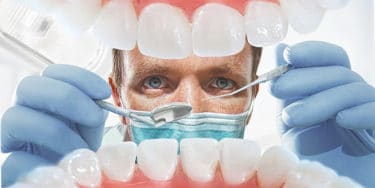With the advances in technology, dental implant has become the newest method to have a natural tooth. Dental implants are false tooth roots made of titanium that is inserted into the jawbone in a small operation in order to replace the missing teeth. After an implant is put in the jaw bone, the implant is expected to merge with the bone. A false tooth (crown) is then attached to the abutment on the implant to give a real tooth’s look and function. This process can take months. Depending on the mouth and dental structure of the patient, the procedure to be performed and the materials to be used, some stages may be combined together to shorten the duration. The most suitable candidates are non-smokers, older than 18 years old, in good health with healthy gums and appropriate jaw bone. It can be a very successful operation when performed by a trained dentist.
Table of Contents
What are dental implants?
Dental implants are false tooth roots that are inserted in the jawbone to restore the aesthetic postures and functions of the lost, broken or missing teeth. They consist of 3 components: root (titanium screw inserted in natural jaw bone), binder (abutment fixing false tooth to the root) and crown (false tooth).
Who can have dental implants?
People who have:
- one or more missing or broken teeth,
- healthy gums and jaw bone,
- no health problems that can affect bone healing,
- no possibility of using dentures,
- ability to adapt to a long treatment process,
- no smoking habits,
- and anyone over the age of 18 who has completed bone development, with good health can be a suitable candidate for a dental implant.
The patient should be in good health. For instance, cancer, chemotherapy treatment, radiation to the jaw, smoking addiction, alcoholism, uncontrolled periodontal disease and diabetes may negatively affect merging implants with the bone. Only if diseases are kept under control, implant operation is possible.
What to do before dental implant surgery?
- Review of medical history: The patient’s general health (past and present) condition is investigated to determine his/her suitability for an implant. If deemed necessary, some diagnostic tests may be requested from the patient.
- Comprehensive dental examination: In order to plan in detail where and how the implants will be inserted, the teeth and the jaw are measured, molds are prepared and dental x-ray and three-dimensional (3D) images are taken.
- Treatment plan: It is prepared according to the patient’s condition; in addition to how many teeth should be replaced, factors such as the condition of the jawbone and the remaining teeth are considered.
The dentist may ask the patient to follow some instructions. These are:
- To rinse the mouth with a special anti-bacterial mouthwash such as chlorhexidine and take antibiotics as a precaution several days before the surgery.
- To have a good breakfast on the day of surgery if local anesthesia will be used, and not to eat anything on the day of surgery if sedation or general anesthesia will be used.
Dental implant procedure steps
The surgery is performed in stages, including recovery time between procedures.
1st stage:
- After deciding on the type of anesthesia, the mouth is anesthetized and the area where the implant will be put is cleaned. If there is a tooth to be removed, it is extracted.
- The incision is made to the gum to reveal the bone where the implant will be put.
- A deep hole is drilled into the bone with a special drill to create the space for the implant to act as a tooth root, and the implant is screwed there.
- The gingiva where the incision is made and the implant are covered and 1or 2 sutures are done.
A temporary denture can be placed in the cavity where the tooth is missing. This denture can be removed to clean while sleeping.
2nd stage:
- After the implant is put on the jawbone, it usually takes 2 to 6 months for the jawbone to grow and merge with the implant surface. This time is necessary to build up a solid foundation for the new artificial tooth.
3rd stage:
- After the bone growth and healing process are completed, an extra surgery may be required to place the abutment.
- The mouth is sedated and gums are reopened to reveal the dental implant.
- The abutment is put on the dental implant, covered with gum tissue and sutured.
- After the abutment is placed, gums heal approximately 2 weeks.
Abutment is sometimes put with the implant in the first stage. In this case, 3rd stage is not needed. Abutment passes by the gingival line and can only be seen when the mouth is open. Some people may prefer to wear the abutment later, as they do not wish to be seen with this image until the treatment is completed.
4th stage:
- When the gums heal, a series of appointments begin in order to make a new implant crown, and mouth molds are taken for proper alignment to the mouth.
- The crown is not placed until the jaw bone is strong enough to support the use of new teeth.
- It is decided one of the false teeth, be it removable, fixed or a combination of the two.
Removable false tooth
It is similar to conventional dentures, and can be partial or full. It contains artificial white teeth surrounded by pink plastic gum. Removable false tooth is mounted in a metal frame attached to the implant abutment, and settles safely. It is easily removable for repair or daily cleaning.
Fixed false tooth
It is permanently screwed or glued to a separate implant abutment. It cannot be removed for cleaning teeth or while sleeping. Each crown is attached to its own dental implant. Besides, since implants are very strong, several teeth can be bridged together and replaced with one implant.
5th stage:
- The last step is to put the new crown. Depending on which tooth has been restored, the dentist may perform some rehearsals before the crown is settled in order to check its shape and whether it fits to the mouth.
- When the final decision is made, the false tooth is either screwed or glued.
- It is normal that some small bruises and swelling develop in the gums and soft tissues after the procedure is finished. In order to help reduce swelling, a cold ice bag is placed over the skin immediately after treatment.
How long does a dental implant procedure take?
Among many factors which determine the duration are:
- Overall oral-jaw-dental health of the patient
- The number of teeth concerned
- Which teeth to be replaced
- Presence of a fractured or damaged tooth to be removed before implant operation
The whole process can take up to 6 to 9 months. However, it may take longer if the settlement of the implants are delayed or bone grafting or sinus elevation are required before implantation. These factors also determine the total number of visits paid to the dentist during treatment.
If the bone cannot support the implant because it is too thin or soft, bone grafting (transplant) may be needed, or if there is not enough bone height in the upper jaw or if the sinuses are too close to the jaw, sinus elevation surgery may be necessary.
Bone grafting transplant
This procedure may constitute a more solid base for the implant. Bone graft materials are:
- Natural bone powders taken from the bones in the body
- Synthetic bone powders produced from various materials
Please talk to your doctor about the options that best suit you. It may take several months for the transplanted bone to grow up in order to support a dental implant. In some cases, a small amount of bone graft may be needed that can be taken simultaneously with implant surgery. The condition of your jaw bone determines how you proceed.
Types of dental implants
Endosteal implant
It is the most widespread implant type. Screw-shaped ones are used more frequently. Among other types are cylindrical or knife-shaped ones. Each implant holds one or more prosthetic teeth. It can also be applied to patients with bridges or removable prostheses.
Intramucosal inserts
It is a titanium structure, shaped like mushrooms in order to increase retention in the prosthesis. Nowadays, it is not much preferred, and can only be used in maxillofacial prostheses.
Endodontic stabilizer
It functions as fixing weak teeth. Thus, a more robust infrastructure can be formed on the teeth.
Transosseous (transmandibular) implant
It is a type of implant placed along the bone. Since it is a difficult treatment method, it is not preferred today.
Subperiosteal implant
It consists of a metal frame attached to the jawbone just under the gingival tissue. As the gums heal, the frame is fixed to the jaw bone. Abutments on the frame protrude out of the gums. As with the endosteal implant, false teeth are then attached to the abutments. It is not widely used nowadays because of its weak results in the long-term. It can only be applied to patients who cannot use conventional prosthesis and have minimum bone height.
Does dental implant surgery hurt?
Placing an implant is usually easier than a pulling out a tooth. In general, local anesthesia is given. Sedation is given only if the patient is extremely nervous. General anesthesia is rarely given only if the process is very complicated. After the effect of anesthesia is gone, depending on the treatment the patient has taken, the scale of the pain varies and may take 1 week. Over-the-counter painkillers like ibuprofen (Advil) or acetaminophen (Tylenol) are prescribed for a simple pain.
Stronger painkillers are prescribed for complicated operations and may be required to use them for the whole duration of healing.In addition to painkillers, antibiotics and mouthwash might be prescribed in order to support the healing for a couple of weeks.
Suggestions after dental implant surgery
- Have a perfect mouth hygiene: As you do for your own natural teeth, always keep clean your implants, false teeth and gum tissue. A good mouth hygiene means routine brushing and using a dental floss to avoid food remains and plaques. Some special designs like interdental brushes can help for a comprehensive cleaning.
- Consult your dentist regularly: Schedule visits to your dentist and follow the instructions for a professional cleaning in order to keep the good health and functioning of your implants.
- Avoid harmful habits: Do not chew hard objects such as ice and sugar. Avoid tobacco and caffeinated products. During the treatment, eat only soft foods.
How long do dental implants last?
If the bone to which the implants are inserted is strong and healthy, and the above instructions are followed, implants can be used for many years as natural teeth. However, a lifetime warranty cannot be assured.
Advantages and disadvantages of dental implants
Advantages
- The success rate is close to 98%.
- It is an ideal solution for those who lost their teeth in a disease, injury or accident.
- Dental implants made of lightweight, strong and body-compatible titanium do not slip since they merge with the jawbone, do not make noise, and do not cause damage to the bone in the way that fixed bridges or dentures can do. They also don’t decay like a natural tooth.
- Implants can be applied in single or multiple tooth loss.
- They can also be applied to fix the tooth bridge or dentures.
- If the teeth are damaged after an accident, they can be taken from the implant and replaced with a new one. If the implant is damaged, it can be left in the jaw and another implant is placed next to it.
- Implants appear close to natural teeth and provide better chewing.
- After the procedure, the sense of taste is not affected and the patient’s quality of life increases.
The capacity of titanium to merge with the bone is the biological basis of a dental implant’s success, because when the teeth are lost, the bone supporting them is lost. The dental implant prevents this loss by fixing the bone. It also helps maintain the shape and density of the jawbone. This also supports the facial skeleton and indirectly soft tissue structures such as cheeks and lips.
Risks of dental implants
They are rarely seen, but among the main ones are:
- Infection in the place of implant
- Injury or damage in surrounding teeth or blood vessels
- Nerve damage that may result in pain, numbness or tingling in natural teeth, gums, lips or jaws
- Sinus problems when dental implants inserted in the upper jaw enter one of the sinus cavities
Other potential risks are:
- Infection of the bones and gums surrounding the implant (if left untreated it may lead to loss of dental implant)
- Body’s rejection of dental implant (rare)
- Bone loss around dental implant
- Inability of attachment of a dental implant to the bone
Most dental implants are successful. Nevertheless, the bone sometimes does not sufficiently merge with the metal implant. For instance, smoking may lead to implant’s failure and complications. If the bone does not merge sufficiently, the implant is removed, the bone is cleaned, and the procedure might be restarted approximately 3 months later.
Dental implants warnings
- If a swelling, discomfort or another problem gets worse on the following days of the surgery, please consult your surgeon immediately.
- If you do not look after the implants, plaques similar to those on neglected natural teeth may develop. If left untreated, it can lead to gum infection, bleeding, pain and overall discomfort.
- Since implants like natural teeth can be accidentally damaged, it is important that you use a professional mouthpiece if you are engaged in sports involving contact or moving objects.
- If you continue smoking, you should look after your implants more carefully. (Some dentists reject smokers to place dental implants.)
Dental implants prices
Costs vary depending on the patient’s jaw structure, missing teeth and which operations they will undergo as well as the quality of the material used. Make sure to understand all the steps that will involve in the operation before starting treatment. If your health insurance covers this procedure, ask how much you will receive.




